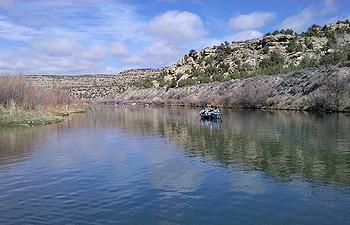Navajo-Gallup Water Supply Project Construction Begins
GALLUP, New Mexico, June 4, 2012 (ENS) - Federal government and Navajo Nation officials Saturday broke ground on the Navajo-Gallup Water Supply Project, which will deliver clean running water from the San Juan River to 200,000 members of the Navajo Nation, a first for many.
Hundreds of workers are starting to construct 280 miles of pipeline, two water treatment plants and a delivery system that will serve 43 Navajo chapters, the southwest portion of the Jicarilla Apache Nation, and the city of Gallup - a population expected to hit 250,000 by the year 2040.
 |
The San Juan River as it flows through New Mexico (Photo by Amber Wildermuth) |
These arid areas now rely on a rapidly depleting groundwater supply that is of poor quality and inadequate to meet current and future demands. Ground water levels for the city of Gallup have dropped 200 feet over the past 10 years and more than 40 percent of Navajo Nation households haul water to meet their daily needs.
Some communities will get running water within three years and, by law, the system must be completed by 2024.
"I am thankful that the Navajo-Gallup Water Supply Project is about to begin construction," said Navajo Nation President Ben Shelly. "This project is moving the Navajo Nation forward by bringing water to many homes. We will continue to look forward and anticipate the many benefits this project will bring to our people."
The San Juan River joins the Colorado River at Lake Powell, the reservoir created by the Glen Canyon Dam. Lake Powell is a storage facility for the Upper Basin states of the Colorado River Compact - Colorado, Utah, Wyoming, and New Mexico.
The Navajo-Gallup Water Supply Project was authorized by legislation President Barack Obama signed on March 30, 2009 that is a major component of the Navajo Nation San Juan River Basin Water Rights Settlement in New Mexico. The Indian water rights settlement resolved decades of uncertainty and dispute over water rights for the Navajo Nation and other water users in New Mexico.
Joining President Shelly at the ground-breaking ceremony were: Secretary of the Interior Ken Salazar, U.S. Senators Jeff Bingaman and Tom Udall, Bureau of Reclamation Commissioner Mike Connor, Navajo Nation Council Speaker Johnny Naize, Jicarilla Apache Nation President Levi Pesata, New Mexico Engineer Scott Verhines, and City of Gallup Mayor Jackie McKinney.
"We are turning dirt today on this project because President Obama has put such a high priority on honoring our commitments to Indian nations, to resolving long-standing water disputes, and to jump-starting major American infrastructure projects," said Secretary Salazar.
"It is simply unacceptable that four in 10 members of the Navajo Nation must haul their water, often over long distances, from water stations," said Salazar. "This project will be an engine for economic growth, create jobs, and supply the lifeblood for communities that have been without running water for far too long."
The ground breaking marked the beginning of construction on the first four miles of the main pipeline, which will be constructed as part of Reach 12A near Tohlakai Hill, outside of Gallup.
"Over the past three years, we have reached unprecedented and historic Indian water rights settlements that provide secure water supplies for communities and certainty to all water users," said Bureau of Reclamation Commissioner Michael Connor.
"To see the Navajo-Gallup Project break ground is to be reminded that consensus-building and cooperation can bring about real and lasting change for communities that still do not have clean and reliable water supplies," said Connor. "Today is a proud day."
The initial stage of construction on the project will create at least 450 jobs, with more than 650 jobs at peak construction, providing employment opportunities and economic benefits to neighboring American Indian communities.
In addition to project reaches to be completed by the Bureau of Reclamation under its own authorities, other portions will be constructed by the city of Gallup, the Navajo Nation, and the Indian Health Service in accordance with financial assistance agreements with the Bureau of Reclamation.
The project is one of 14 high-priority infrastructure initiatives being expedited by the Obama administration as a result of a Presidential Memorandum issued in August 2011 that directs federal agencies to improve infrastructure permitting and environmental review processes.
Copyright Environment News Service (ENS) 2012. All rights reserved.